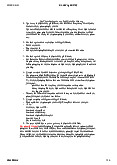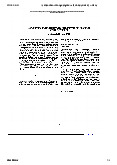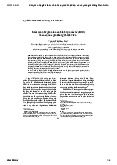





Preview text:
19:02 1/8/24 Taiwan's economic miracle
Chapter 2: Taiwan’s advancements under the Japanese colonial rule
Taiwan's economy is only largely known after the 17th century and was a
primarily agricultural economy for a long period. The island’s favorable
groundwork for the later miracle economic development in the 20th was the
cumulative results of government policies under two successive regimes in
Taiwan, namely the Japanese colonial and the Nationalist authoritarian. Chapter
2 of this paper delves into the historical background under Japanese rule to
provide insight into the economic situation before the transformative period.
The Japanese gained control of Taiwan in 1895 after the Sino-Japanese
War and started to modernize the island for the benefit of the colonial power1.
Under Japanese colonial domination, Taiwan underwent many significant
economic development initiatives led by the colonial state. While the Japanese
Empire exploited nature, extracting resources and surplus from Taiwan, its
policies also altered Taiwan's economic structure and prepared the groundwork
for the later growth of the island.
A key advantage that Taiwan inherited from the Japanese rule was the
large-scale infrastructure construction including transportation networks, power
grids, and irrigation systems. In terms of infrastructure sector, the Japanese
initiated many major infrastructure projects to create an extensive transportation
network of roads, railroads, and ports, such as building 10,000km of roads and
railroads from Keelung in the north to Kaohsiung in the south2. Along with
infrastructure, irrigation systems were also invested during this period to boost
agricultural productivity. For example, the colonial authority invested 60
percent of the cost for water control and irrigation systems covering two-thirds
of the cultivated land by the 1940s3. On power development, Japan focused
1 Olds, Kelly.,2008. “The Economic History of Taiwan”. EH.Net Encyclopedia, edited by Robert Whaples,
March 16. Available at: https://eh.net/encyclopedia/the-economic-history-of-taiwan/ (Accessed 18 May 2024).
2 van der Wees, G. 2018.Contrasting conceptions of colonial rule. Taipei Times, December 11. Available at:
https://www.taipeitimes.com/News/feat/archives/2018/12/11/2003705889 (Accessed 18 May 2024).
3 Tun-Jen, C., 2001. Transforming Taiwan's economic structure in the 20th century. The China Quarterly, 165, pp.19-36. about:blank 1/6 19:02 1/8/24 Taiwan's economic miracle
heavily on building 36 different electric-generating stations in Taiwan, most
notably the massive station completed at Sun Moon Lake (1934), to stimulate
the growth of industrialization4. These infrastructure developments laid a robust
foundation for Taiwan's post-war economic transformation and further impacted
the island’s later miracle growth.
During its colonization era, Japan also played an important role in
establishing the education system in Taiwan, which led to considerable
improvement in human resources and state capacity. The colonial state
emphasized more on literacy and vocational training to create a workforce
equipped for the industrial economy. The increase in literacy rate from just 1%
in 1905 to 27% in 1940 and the rise in elementary school enrollments from
8.7% to 57% in the same period were certain evidence of the success of Japan’s
education policy in Taiwan5. As a result, under Japanese colonialism, only
14.8% of men were classed as unskilled manual workers, while semi-skilled and
skilled manual workers made up 46.2%, which showed the quality of the labor
force was enhanced significantly6. Moreover, some Taiwanese during this
period were also sent to the ruling country for higher education, which
facilitated the development of Taiwan in the following years. During the
Japanese colonial era, death mota Generally, Japan considerably enhanced the
quality of the labor force on the island, which further remained a valuable asset
for Taiwan's post-war industrialization efforts.
Another noteworthy advancement that Taiwan gained from Japanese
colonization was exposure to modern technologies and management practices,
which influenced its approach to industrialization after the war. Under Japanese
rule, Taiwan’s economy still focused on agriculture but transitioned from
4 Hayashi, J.H., 2023. Hydraulic Taiwan: Colonial Conservation under Japanese Imperial and Chinese
Nationalist Rule, 1895-1964 (Doctoral dissertation, Harvard University).
5 Tun-Jen, C., 2001. Transforming Taiwan's economic structure in the 20th century. The China Quarterly, 165, pp.19-36.
6 Morgan, S. L., & Liu, S., 2007. Was Japanese Colonialism Good for the Welfare of Taiwanese? Stature and the
Standard of Living. The China Quarterly, pp. 990–1017. JSTOR, http://www.jstor.org/stable/20192858 (Accessed 18 May 2024). about:blank 2/6 19:02 1/8/24 Taiwan's economic miracle traditional subsistence toward commercial, market-oriented. To boost
productivity, the Japanese introduced new inputs, technologies, and rural
institutions like agricultural cooperatives and extension services that upgraded
techniques and linked farmers to wider markets. Thanks to Japanese reform,
about a decade after the Japanese takeover, Taiwan took the leading position in
rice and sugar exports till the eve of the Second World War7. While agriculture
was significantly transformed, industrial development also began but was more
limited, with industries mainly confined to sugar refining and other food
processing supporting the agricultural sector. Although being narrowed, the
nascent industrial push produced a diversified modern economic base in Taiwan.
Overall, the Japanese colonial rule, despite its exploitation of Taiwan,
played a pivotal role in reshaping Taiwan's economy with many innovative
projects regarding infrastructure, education, agriculture and manufacturing.
These foundational developments were instrumental in Taiwan's evolution into a
relatively stable and prosperous Japanese colony with growth in Taiwan’s
per-capita economic product during this colonial period roughly keeping up
with that of Japan8. The accumulation of these factors under Japanese
domination remained a crucial asset for further development in Taiwan.
3. Early economic development under the Nationalist Party
Taiwan was only under Japanese domination for 50 years. In 1945, Japan
was defeated in World War II. Following that, Taiwan transitioned from
Japanese rule to the governance of the Republic of China (ROC) under the
Kuomintang (KMT). Chapter 3 investigates the economic situation of Taiwan
after World War II and analyzes some economic policies on the island under new government rule.
7 Tun-Jen, C., 2001. Transforming Taiwan's economic structure in the 20th century. The China Quarterly, 165, pp.19-36
8 Olds, Kelly.,2008. The Economic History of Taiwan. EH.Net Encyclopedia, edited by Robert Whaples, March
16. Available at: https://eh.net/encyclopedia/the-economic-history-of-taiwan/ (Accessed 18 May 2024). about:blank 3/6 19:02 1/8/24 Taiwan's economic miracle
After achieving victory in World War II against Japan and the remaining
Axis powers, but suffering a subsequent defeat in the Chinese Civil War, the
Kuomintang (Chinese Nationalist Party) fled the mainland for Taiwan and
brought with them much of China’s gold reserves and human capital. After
World War II, Taiwan was in bad shape, as it endured bombings during the war
and an influx of about 1.5 million mainland immigrants. The KMT government
which seized power in Taiwan in 1945 had to cope with several difficulties such
as weakened infrastructure, hyperinflation and so on. Thanks to Japan’s
relatively comprehensive setting up of the island, the KMT regime only had to
restore the relics after the war for further development. Their early policies
aimed to consolidate political control, address economic dislocations, and lay
the foundations for Taiwan's future state-led development model.
The top priority of the new Taiwanese government was to stabilize
inflation, which was at very rapid rates during the period 1945-1949, reaching at
times more than 100% per month9. The government’s series of policies along
with the aid from the U.S. helped Taiwan stabilize the currency and curb
inflation. The most noticeable policy was the creation of the NT$, which was to
be 100% backed by gold reserves taken from China and pegged to the USD at a
rate of 5:1.10 Thus, the stabilization policies of the government succeeded,
paving the way for other developments on the island.
Another goal of the KMT government in developing Taiwan was a series
of land reforms aimed at redistributing farmland from wealthy landlords to
tenant farmers and the landless poor. Besides the Japanese government, the
Sino-American Joint Commission on Rural Reconstruction (JCRR) also played
an important role in land reform, the rebuilding of rural infrastructure and the
9 Phylaktis, K. & Taylor M. P., 1992. The Monetary Dynamics of Sustained High Inflation: Taiwan, 1945-1949.
Southern Economic Journal, vol. 58, no. 3, 1992, pp. 610–22. JSTOR, Available at:
https://doi.org/10.2307/1059829 (Accessed 19 May 2024).
10 Burdekin, R.C.K. and Whited, H.H.I.H., 2001. Multiple Regime Shifts and Multiple Ends of the Taiwanese
Hyperinflation, 1945-1953. Southern Economic Journal, 68(1), pp.77-91. JSTOR, Available at:
https://doi.org/10.2307/1061512 (Accessed 19 May 2024). about:blank 4/6 19:02 1/8/24 Taiwan's economic miracle
increase of agricultural productivity. Therefore, the agricultural sector witnessed
a positive rise, which would serve as the primary surplus generator funding
industrial investments in the 1960s.11 Moreover, by keeping landholdings small
combined with taxes and pricing, the labor structure was also changed as
farmers would have to go to other jobs, creating a cheap labor force for the
industry when it began to expand.12
In terms of education, the KMT government also introduced policies to
rebuild and upgrade Taiwan's human capital base, which had seen an expansion
of education and skills under Japanese colonial rule. Over time, however,
educational opportunities expanded for all Taiwanese.13 This steady buildup of
human capital, combined with outward migration by educated Taiwanese to
acquire skills abroad, paid off as Taiwan transitioned to an economy focused on
labor-intensive manufacturing exports beginning in the 1960s. The government
introduced an educational reform that extended the years of basic schooling and
expanded technical training, which was known as the Nine Year Popular
Education Policy (1968-1969). As a result, illiteracy rates of those above six
years old dropped dramatically, from 42% (1952) to 7.1% (1989). At the same
time, the ratio of population with a middle-school level education rose from 8.8% (1952) to 44.9% (1989).14
By and large, after 1945, the Nationalist government played an important
role in restoring and developing Taiwan’s economy. They have enacted a series
of critical reforms from stabilizing inflation and rebalancing agriculture through
land redistribution to investing in human capital by expanding education -
which laid the groundwork for Taiwan's later economic miracle driven by an
11 Huang, C.C., 1998. Historical reflections on the postwar Taiwan experience from an agrarian perspective.
Postwar Taiwan in Historical Perspective, 1, pp.17-35.
12 Gates, H., 1988. Chinese working-class lives: Getting by in Taiwan (p. 270). Cornell University Press, pp. 50-67.
13 Gates, H., 1988. Chinese working-class lives: Getting by in Taiwan (p. 270). Cornell University Press, pp. 50-67.
14 Huang, C.C., 1998. Historical reflections on the postwar Taiwan experience from an agrarian perspective.
Postwar Taiwan in Historical Perspective, 1, pp.17-35. about:blank 5/6 19:02 1/8/24 Taiwan's economic miracle
increasingly skilled population and productive rural sector capable of funding
industrial development initiatives. about:blank 6/6




